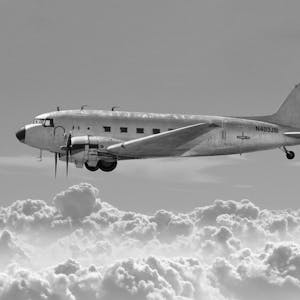Flight mechanics - The basis
More than one century after the Wright brothers’ first flight, the flight still defy our intuition. You will learn here how to name the different parts of the airplane and how to describe and quantify its geometry. For that, we need now to share a precise vocabulary to describe the airplane’s movement and attitude in space, and a refresher on basic general mechanic principles. You will remind how Newton’s 2nd law allows you to determine what force must be applied on an apple - or on an airplane, to modify the magnitude and direction of its speed. Coming back on the concepts of kinetic energy and potential energy, you will discover the very useful concept of total height and you will be able to explain how an airplane can quickly exchange speed for altitude, while changes in total height are much slower. In the end, you will discover that only a very small number of forces apply on an airplane in flight and that you will be able to classify those that change its energy state and those that modify its trajectory. You will discover the concept of load factor and understand why the pilot of a combat aircraft can feel a weight nine-time greater than his actual weight! Finally, we will establish the lift and propulsion equations, that form the basis of flight mechanics, and you will be able to compute the lift and thrust necessary to follow a given trajectory at a given speed.
This course is for anybody interested in learning more about how planes work, the physics of flying, or flight mechanics. It will be of particular interest to undergraduate students in aerospace engineering, trainees as well as senior pilots, journalists, and professionals in the aeronautics sector.
Although some mathematical formalism may be present sometimes. It is always doubled by sketches, figures, and hands-explanations. So that, anybody can skip the formulas without losing the core understanding of the concepts.
No apples were harmed in the making of this course…
This course is only a foretaste of the mechanics of flight. ISAE-SUPAERO and Eric Poquillon will offer you other courses and the first specialization in autumn 2021. Initially, three courses will be published to answer several questions: Can we fly as high as we want? What is a stall? Why do some planes have propellers and others have jet engines? Is an airplane always stable? How do you control an airplane following an engine failure? All this and more will be covered in this series of flight mechanics courses.
This course is a part of the specialization “Fundamentals of Flight mechanics”.
Use precise and appropriate words to describe an airplane and its motion in the air.
Apply Newton's law to compute the evolution of the trajectory of an airplane, based on the aerodynamic forces acting on it.
Syllabus
Syllabus - What you will learn from this course
Week 1
Anatomy of the plane
Week 2
Vocabulary and Tools
Week 3
Basis of flight mechanics
Graded assessment for the course
FAQ
When will I have access to the lectures and assignments?
Access to lectures and assignments depends on your type of enrollment. If you take a course in audit mode, you will be able to see most course materials for free. To access graded assignments and to earn a Certificate, you will need to purchase the Certificate experience, during or after your audit. If you don't see the audit option:
The course may not offer an audit option. You can try a Free Trial instead, or apply for Financial Aid.
The course may offer 'Full Course, No Certificate' instead. This option lets you see all course materials, submit required assessments, and get a final grade. This also means that you will not be able to purchase a Certificate experience.
What will I get if I subscribe to this Specialization?
When you enroll in the course, you get access to all of the courses in the Specialization, and you earn a certificate when you complete the work. Your electronic Certificate will be added to your Accomplishments page - from there, you can print your Certificate or add it to your LinkedIn profile. If you only want to read and view the course content, you can audit the course for free.
Is financial aid available?
Yes. In select learning programs, you can apply for financial aid or a scholarship if you can’t afford the enrollment fee. If fin aid or scholarship is available for your learning program selection, you’ll find a link to apply on the description page.
Reviews
It was a really great course with short and informative videos and also very meaningful quizzes and assignment. I am glad that I chose this course.
I have a great experienced in following this course. Great explanation and instruction from ISAE-SUPAERO adn Mr. Eric
The videos were extremely concise, and I felt I really learned a lot from this course. Although I'm 13 years old, I managed to push through with my love for planes.
It was awasome. There is some missings in me but now I know them.
Thanks to you.
